Types and varieties of Potentilla
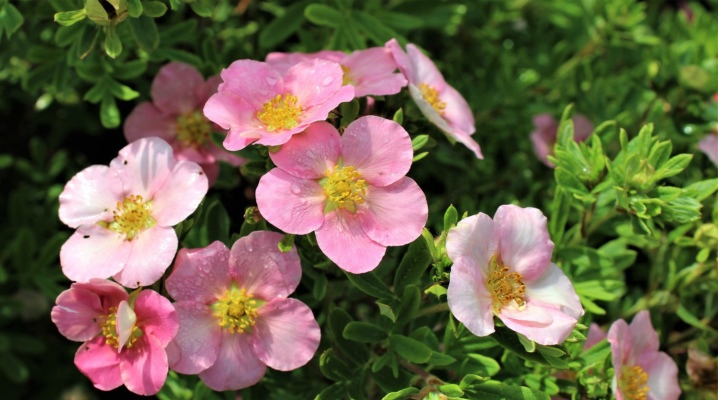
The cinquefoil plant has earned its name due to its external resemblance to the paw of an animal or a human palm. People also call it five-leafed leaf, Kuril tea, "cat's paw", Dubrovka. In total, more than 300 varieties of this plant are known, and in order to describe them all, we would need to write a book. The article will consider the most popular types of Potentilla with a description.
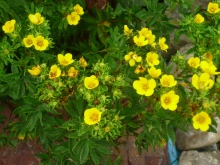

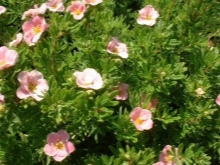
Types and their description
So, let's get to know each other.
Kalgan (Potentilla straight, erect)
Habitat - European countries (except for the southern regions), the Caucasus, Asia Minor; in the Russian Federation, it is found in Siberia, in the middle zone (non-black earth). Small yellow flowers up to 1 cm in diameter are crowned with elongated pedicels. Sepals are ovoid, the outer ones are narrower than the inner ones. In the middle of the flower there is a cluster of stamens (up to 20 pieces).
Galangal foliage at the roots is trifoliate, long-petiolate, sessile on the stem. The leaves themselves are oblong, decorated with cloves. Stem height - about 30 cm. Flowering period - June-July, fruiting - July-August. Galangal fruits are egg-shaped, shriveled.
The plant prefers to live in places with high humidity: in swamps, in damp forests, in flooded meadows, wastelands.
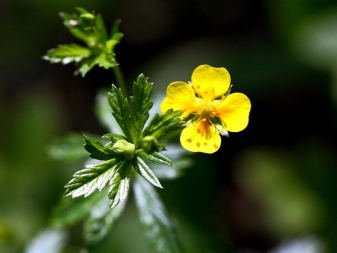
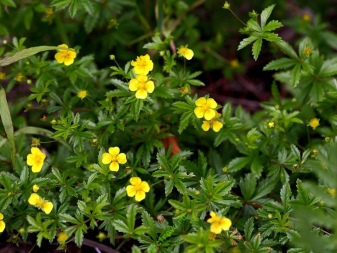
Forked cinquefoil
Perennial plant. It can grow in height up to 25 cm. The parts of the stem, located underground, are lignified, above the ground they are like that only at the base. Stem leaves, with stipules, pubescent, glabrous dorsally. The flower of the forked Potentilla is yellow, reaches a diameter of 1.5 cm, the petals are obovate.
The plant blooms in June-August. In nature, it grows in the east of Siberia, in some European regions of the Russian Federation, as well as in Dagestan, Transcaucasia, Central Asian regions.
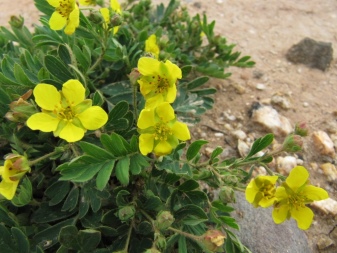
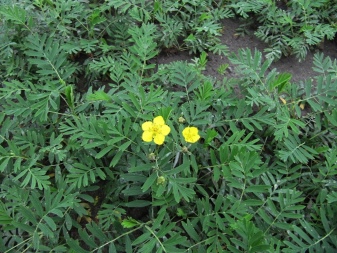
Intermediate
Small yellow flowers are collected in an inflorescence at the top of the stem, whose height is about 20 cm. At the roots, the leaves are long-petiolate, consist of 5 wedge-shaped sections with denticles; on the stems, the leaves are three-section, pubescent on both sides, arranged alternately.
Potentilla grows intermediate along the roadsides, from the edge of a field or meadow, in a forest at the edge. Loves dry and sandy soil.
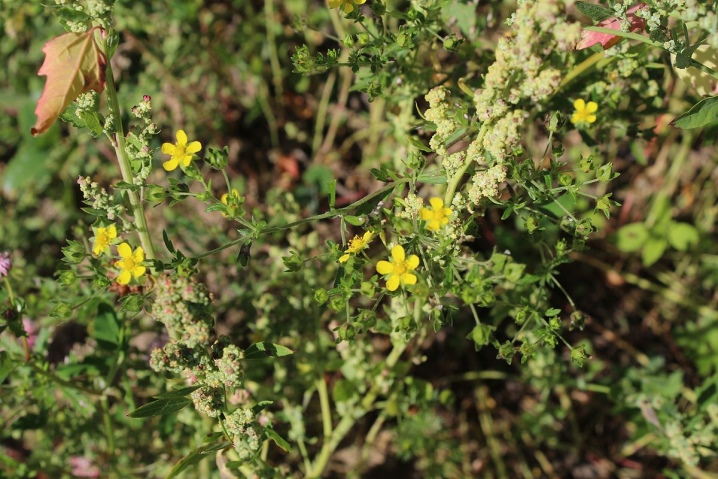
Prostrate
Flowers are yellow, up to 1.5 cm in diameter, collected in corymbose-paniculate inflorescence. There is pubescence on the stems and leaf petioles. The fruits are smooth. The plant lives in the steppe zone, in dry meadows, on the outskirts of a pine forest.
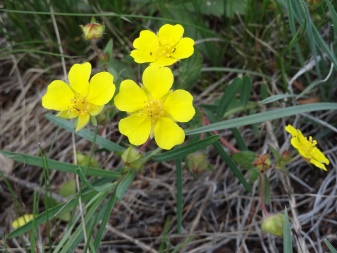
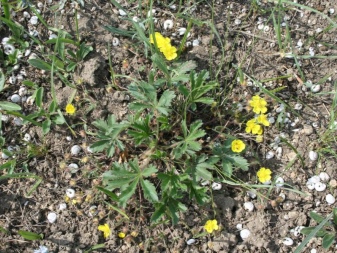
Multi-cut
It grows up to 20 cm in height, the stems are slightly bent in an arc, the petioles of the leaves too. The leaves themselves are pinnate, dissected, 2 pairs per petiole, elongated, pubescent below.
Flowers are up to 1 cm in diameter, collected in an inflorescence. Sepals oblong outside, linear, equal in length to internal ovoid.
Grows on salty soils, lawns, forest edges, rocky slopes.
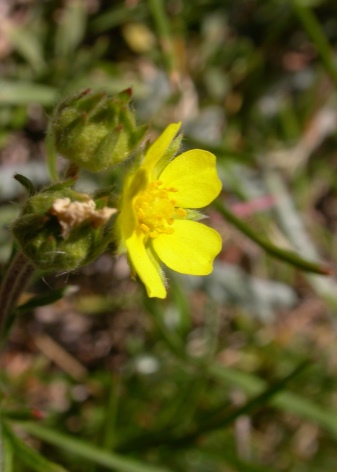
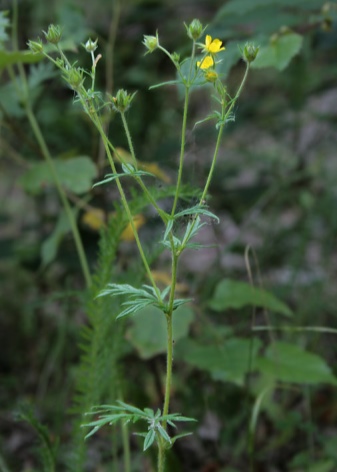
Low (recumbent)
Grows up to 50 cm in height. The stem is erect, with a small downy, leafy. Leaves of the pinnate type, with denticles, have up to 11 sections on the petiole. Flowers are yellow, up to 1 cm in diameter, five-petal, collected in paniculate inflorescences.
Lying cinquefoil can be found in the meadow. The habitat is Siberia and the European part of the Russian Federation.


Sandy
Low plant (only 5-15 cm tall), perennial. It has a raised stem, pubescent, gray tomentose. The leaves at the roots have 5 sections, on the stem - 3.The shape is wedge-shaped, obovate, with denticles at the ends. Bright golden small flowers (up to 1.5 cm) sit on long pedicels. The flowering period of Potentilla sandy is March-April.
The plant grows in the forest-steppe with good insolation, in stony dry areas, in pastures.
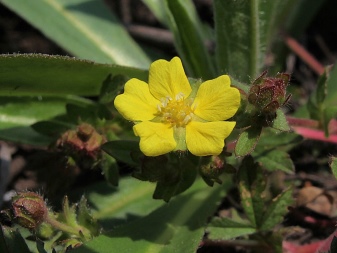

Golden-flowered
A perennial plant 15-40 cm high. It is characterized by thin raised stems, on which there is a slight pubescence and individual long hairs. At the roots, the leaves are five-toed, long-petiolate; in the middle - the same, and above three-toed, practically sitting on a stem without a shank (or it is very short). The flowers of this type of Potentilla, as the name implies, are colored golden yellow. The flowering period is May-July. You can meet the plant in meadows, slopes, in sparse forests.
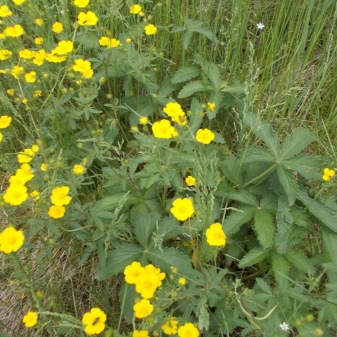
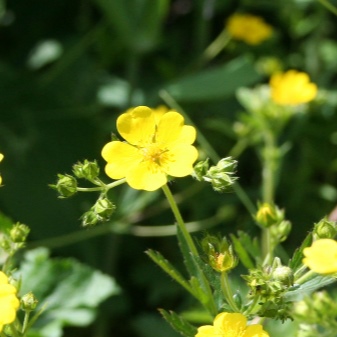
Long-leaved
Tall (up to half a meter) perennial with erect stems. At the roots and below, the leaves are long-petiolized, three- or five-toed, on top of the stem they have 2-3 sections. The flower is small, yellow, with obovate petals. The flowering period is June-August.
Grows in meadows, sunny forest edges, grassy and rocky slopes.
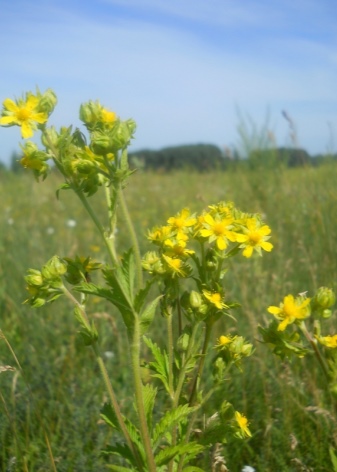
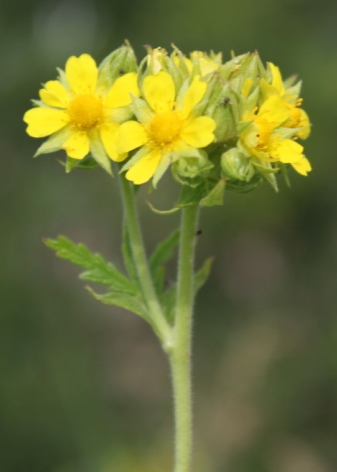
Strawberry
Received this name for the leaves-triad, reminiscent of strawberry. It grows up to 25 cm in height, the flowers have a diameter of 0.8-1.2 cm. The petals are colored yellow, the leaves are green. The flowering period of the plant is June-July. Found in the west and east of Siberia, in the Far East. He loves meadows, rocky slopes, shrubs very much.

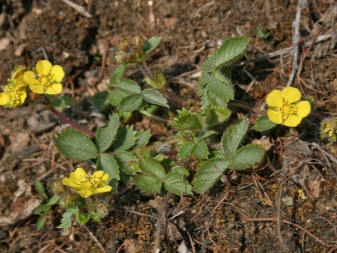
Grayish
Quite tall perennial (up to 65 cm). Stems are erect, pubescent. The leaf petioles are shortened when approaching the top of the stem, and are divided into 3-5 sections. The grayish cinquefoil got its name for the appearance of the leaves, which resemble white felt from below. The flowers are yellow, medium-sized, the sepals are shorter than the petals.
The flowering period is July-August. It can be found on the roadsides, in the steppe zones, in the meadow, in the field.
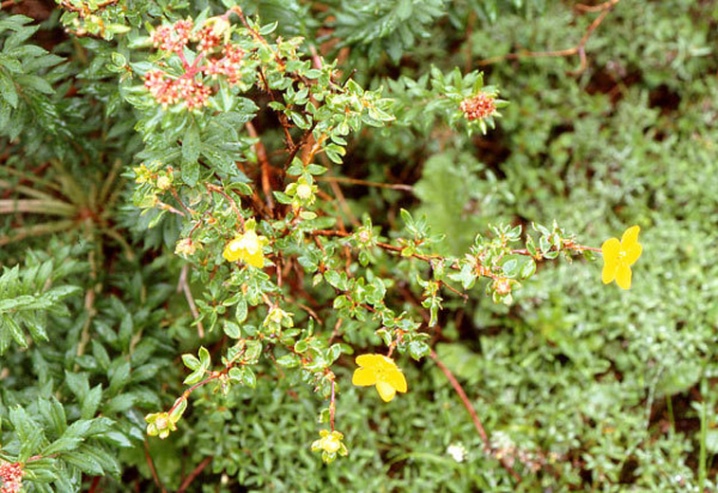
Silvery
Perennial plant with a raised stem up to 30 cm high. Leaves are elongated, petiolar. The flowers are small, only 1-1.2 cm in diameter, yellowish, with splayed petals. They are collected in inflorescences. The flowering period is June-August.
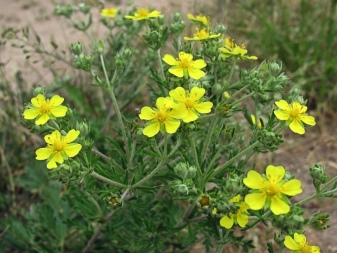
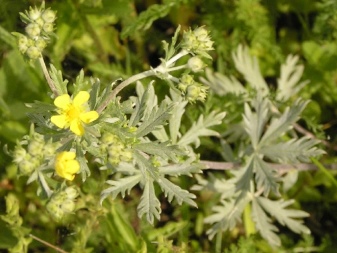
Large-flowered
As the name implies, the plant boasts flowers that exceed all of the above species in diameter. So it is: their size ranges from 3.5 to 4.5 cm. Large-flowered cinquefoil grows to a height of 20-30 cm. Stems are raised, leaves are heart-shaped, rounded, pubescent. Flowers are clustered in corymbose inflorescences.
The plant's habitat is rather narrow - it grows on Sakhalin, the Kuril Islands, in the north of Japan. The flowering period is May-June.
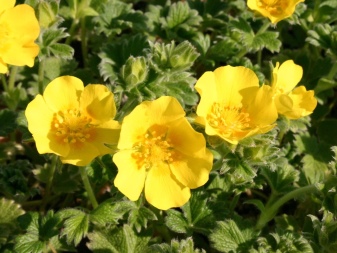
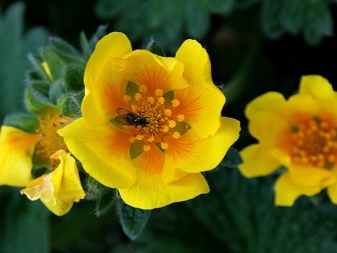
Rowan-leaved (tansy-leaved)
A short (up to 15 cm) perennial with straight stems and large pinnately dissected leaves. Flower petals are rounded, crowded, collected in inflorescences. The fruit resembles a small smooth nut, ovoid.
The habitat of the plant is the west and east of Siberia, the Altai Territory, the Far Eastern regions of the Russian Federation.
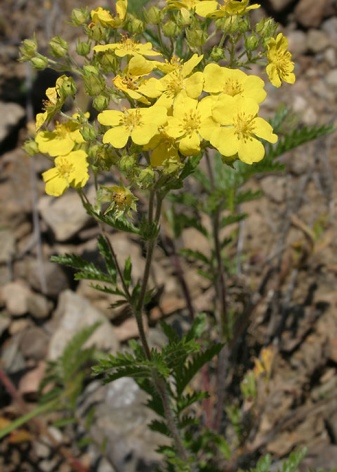
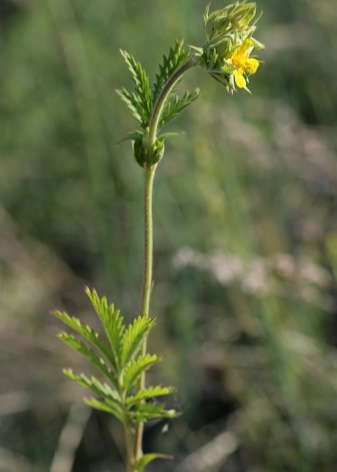
Dwarf
This species includes several subspecies, but they are united by drought and frost resistance, unpretentiousness. You can find plants with flowers of different shades - not only ordinary yellow, but also orange, white and even red.

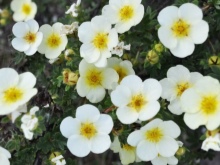
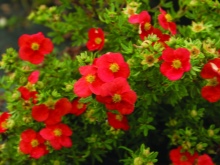
Varieties
So we got to the cultivated varieties of Potentilla. Consider the most popular hybrid varieties that were obtained from crossing different types of Potentilla.
- "Master Floris" - a profusely flowering plant, flowers are ordinary, rather large, yellow-red.
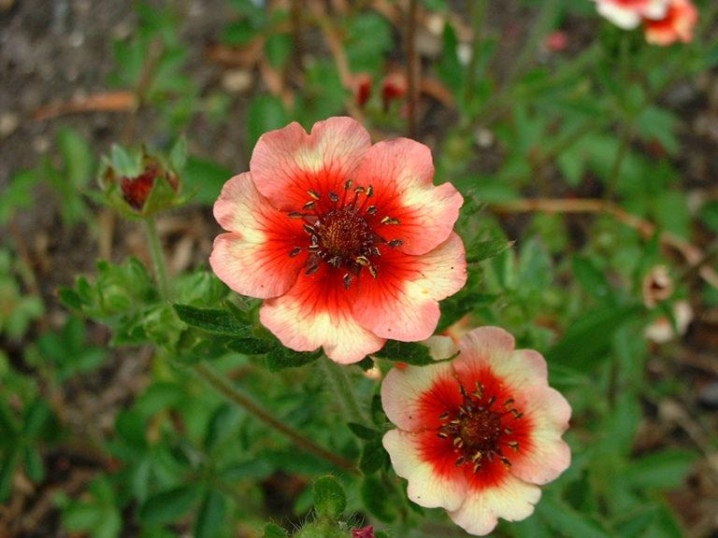
- "Yellow Queen" - has bright yellow shiny flowers, grows up to 30 cm in height.

- Flamboyand - plant of medium height (30-40 cm), blooms in June-August. It is often used as a ground cover. It has flowers of a very unusual shade for Potentilla - dark red.

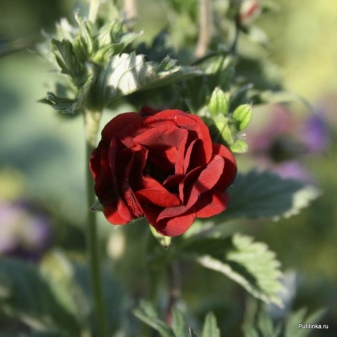
- "William Rollisson" - grows up to 40 cm, flower petals are red-orange, semi-double.
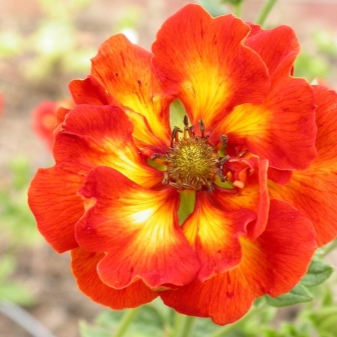

- "Summer motive". It is a mixture of several varieties. It is characterized by unpretentiousness, rapid growth. The height of the mix is 15-40 cm. It is sown in open ground in the period from April to September. Flowering can be expected up to 2 years after planting. Suitable for hobby gardeners as the first horticultural crop.
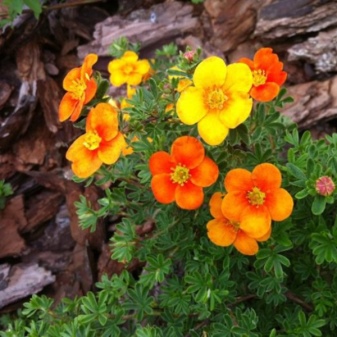
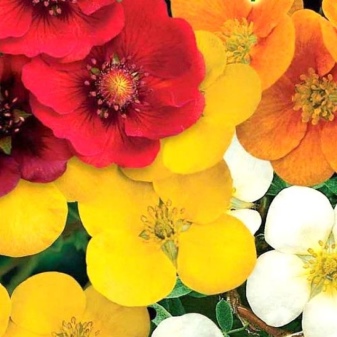
- "Kobold". Shrub variety. It has a dense pillow-shaped crown with a diameter of 120 cm, blooms profusely with large rich yellow flowers. In height "Kobold" can grow up to 60 cm. The foliage is light green. The flowering period occurs in June-July, but some flowers remain on the bush until almost October.
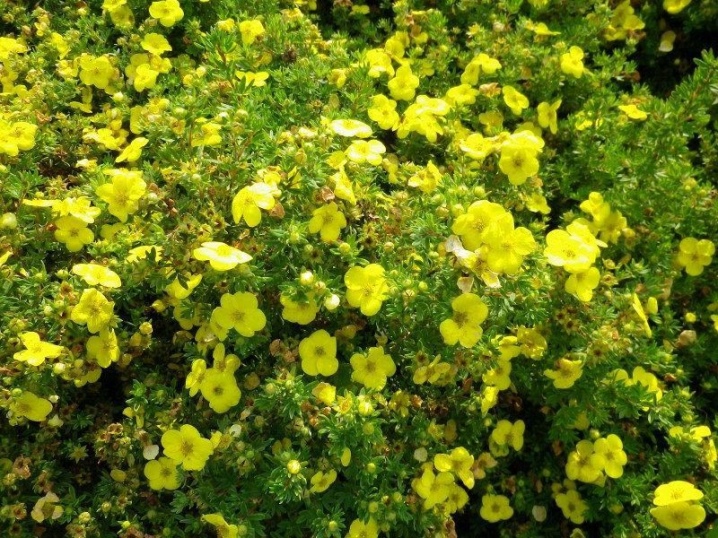
- "Non-shiny". Perennial 20-50 cm high. Stem is straight, thin-lined. Below the leaves are seven- and five-toed, petiolate, from above their petioles are shortened, the leaves themselves are oblong, obovate. Flowers of a yellow hue up to 1.5 cm in diameter, form inflorescences.
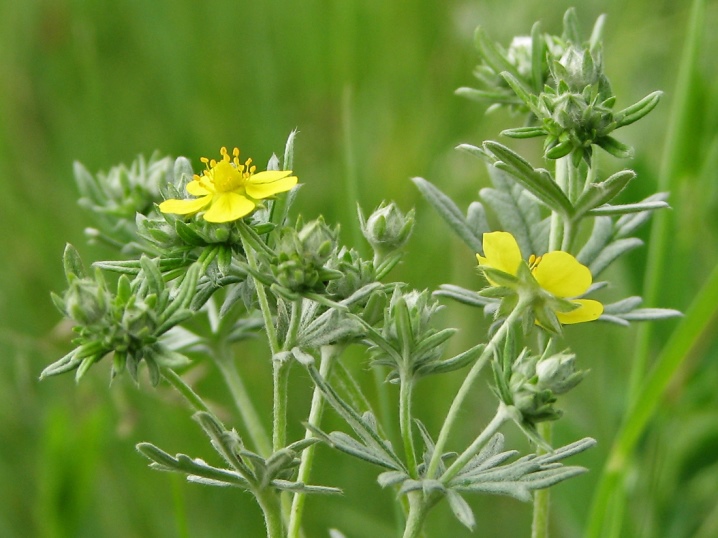
- Tilford Cream. Shrub variety. It has a rounded shape, in height it can grow up to 100 cm, in width - up to 80. The leaves are five-toed (rarely 3- and 7-), the flowers are white-cream, from 3.5 to 5 cm in diameter. They can grow both singly and "cluster" into racemose inflorescences. The flowering period is May-October.
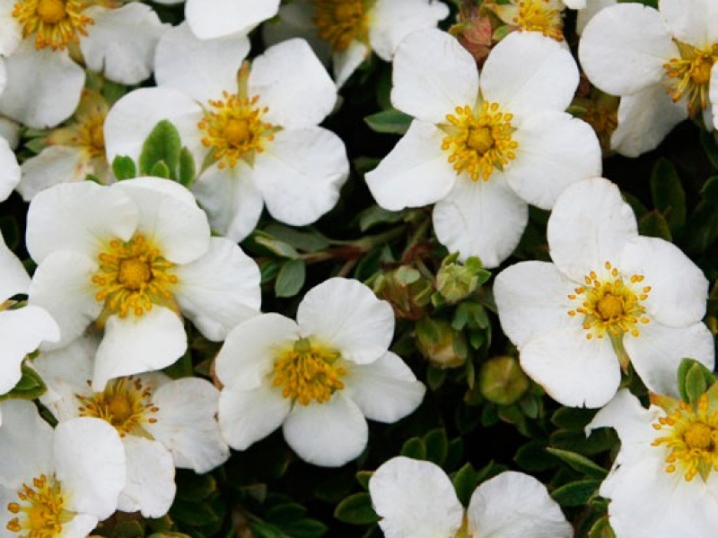
- Hopless Orange. Shrub variety. It reaches a height of 80 cm. The flowers have an unusual color - they are red-orange, very bright. The leaves are small, delicate. Group disembarkation recommended.
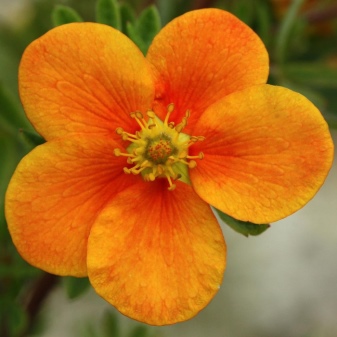
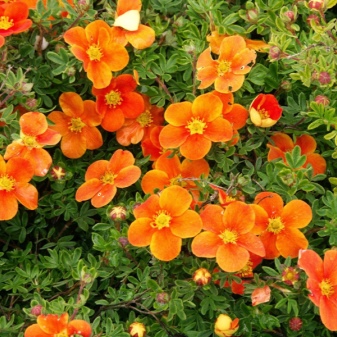
- Summerfloor. Another shrub. Height - up to 80 cm, crown width - up to 100 cm. Leaves are small, feathery, pillow-shaped crown, dense. The flowers are large, about 5 cm in diameter, yellow in color. The flowering period is June-October.

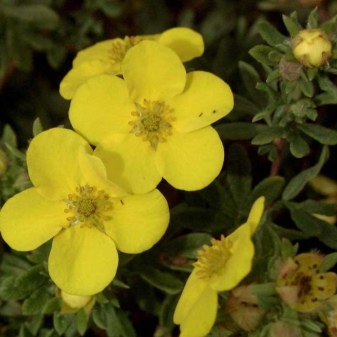
- "Legend". Herbaceous hybrid perennial with stems up to 50 cm high. Flowers are pink-red, rather large (up to 4 cm), form paniculate inflorescences. The plant is characterized by long leaves (up to 30 cm). Disembarkation in groups is recommended. The flowering period is May-September.

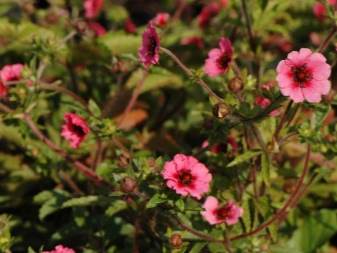
- "Three-toothed". It is often used as a ground cover. The height of the stems is from 5 to 30 cm. Green foliage in summer by autumn acquires a reddish tint. Flowers are very small - up to 0.8 cm in diameter, white, collected in inflorescences. The plant is sun-loving. The flowering period is June-September.
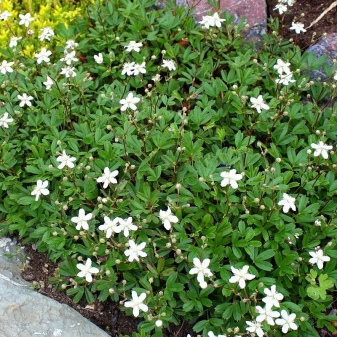
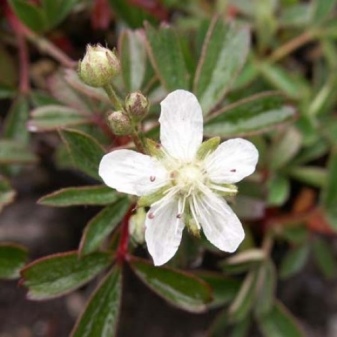
- Goldteppich. Perennial shrub variety. The plant can be sheared, giving the dense crown a variety of shapes. Excellent for planting as a "hedge". The leaves of the variety are five-toed, green, turn yellow by autumn. Flowers are yellow, grow singly or form racemose inflorescences. The flowering period is June-September.
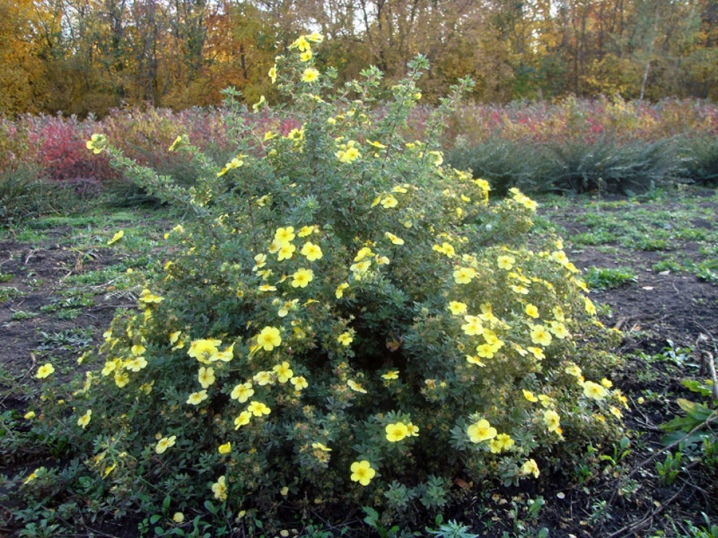
- New Down. Another shrub variety. It can reach a height of 90 cm, has a crown with a diameter of 130 cm. Flowers are pinkish, white below, up to 3 cm in size. The leaves are divided into 3-7 sections, lanceolate. The plant is drought-resistant, not demanding on the composition of the soil. Prefers lighted places, but can grow in partial shade. The flowering period is June-October.

- "Tonga". Ground cover, perennial. It has an interesting color of flowers - they are orange-yellow, and in the middle - burgundy. The plant can grow up to 20 cm in height and bloom in mid-June. The variety is winter-hardy.
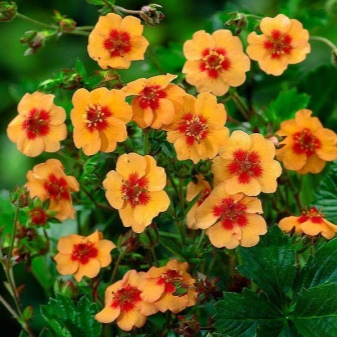
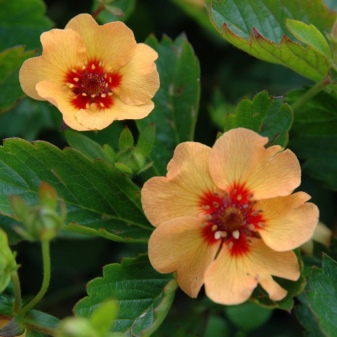
What colors are there?
The classic color of wild Potentilla is yellow. However, with the advent of cultivated varieties, the palette began to change, and varieties appeared that delight with white, cream, light and bright pink, orange, red and burgundy flowers. There are plants with mixed colors and two colors. In this variety, only the blue-blue range is missing.
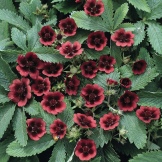
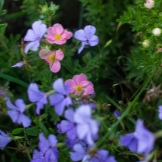
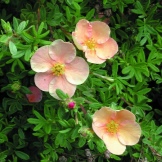

Use in landscape design
Cinquefoil is very loved by landscape designers. It grows quickly, is unpretentious, has a decorative appearance. With the help of planting this plant, you can bring to life many interesting ideas.
- Hedge. Cinquefoil will wonderfully delimit a decorative installation or an entire area.The shrub is also suitable for border planting. It is recommended to place it at some distance from the path or the delineated border, so that it can grow more luxuriantly.

- Alpine slide. Cinquefoil will perfectly complement the rocky rock garden, will place "color spots" in coniferous plantings and ground cover.
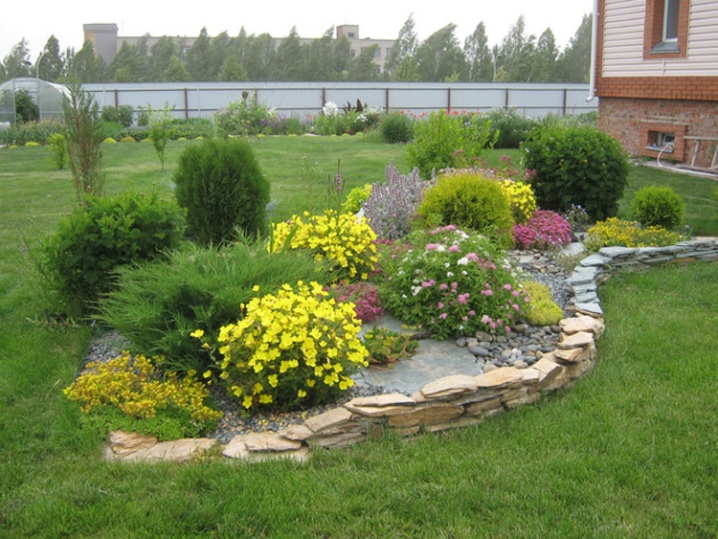
- Flower garden mix. Cinquefoil can be used in combination with other flowering plants, or be the centerpiece of the composition.
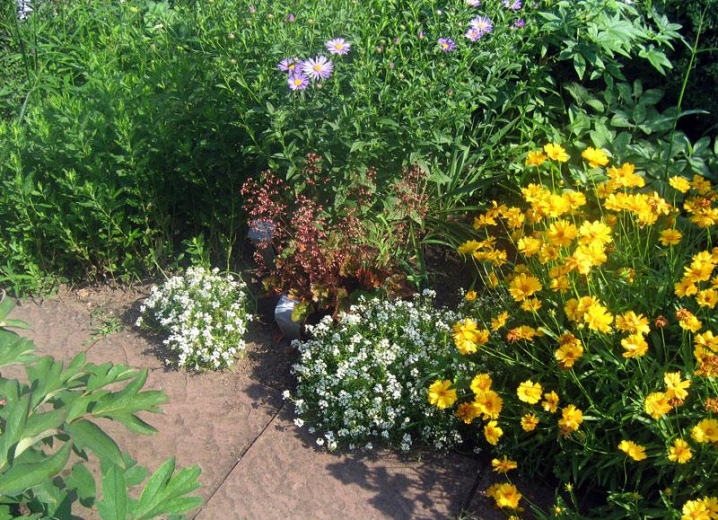
- Planting different types of Potentilla on the same flower bed. If you pick varieties that bloom at different times, you can enjoy the view of a bright flower bed, always covered with flowers of various shades.
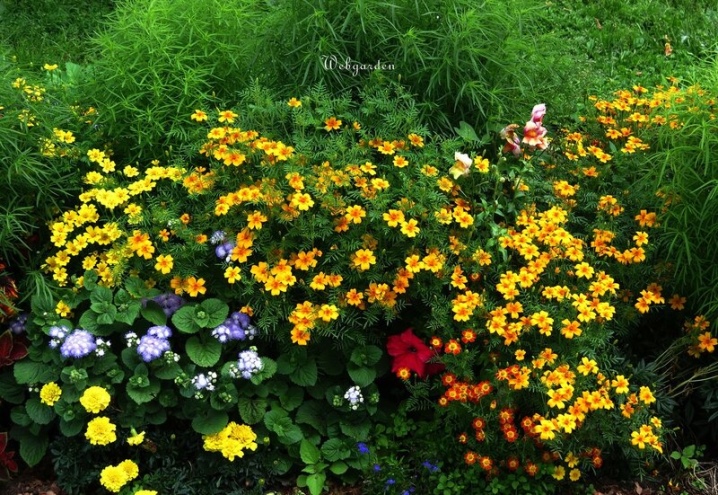
- Reservoir design. If your site has an artificial pond, you can plant Potentilla along its edges. However, remember that you will need to water it much less often due to the presence of a large amount of moisture in the soil.
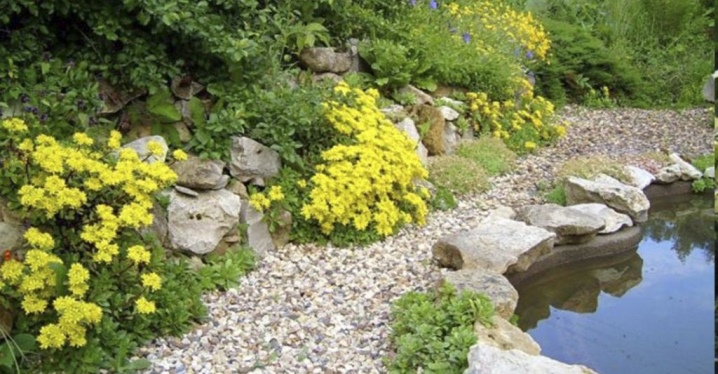
- Stepped disembarkation. An interesting way in which plants are placed in a special structure, folded in the form of steps with the help of partitions. In this case, you will need to cut the cinquefoil and form a beautiful "slide".
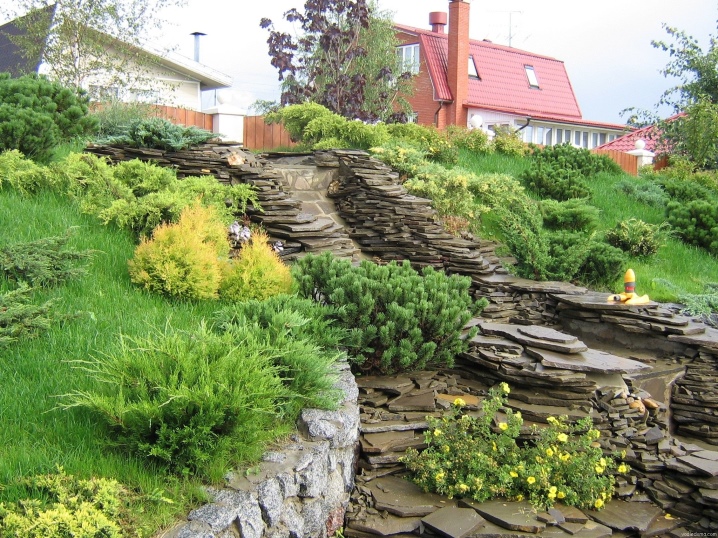
- Single bush. You can focus all your attention on a single Potentilla bush. To do this, you just need to choose a suitable variety, sow the lawn with special grass or cover it with small pebbles.
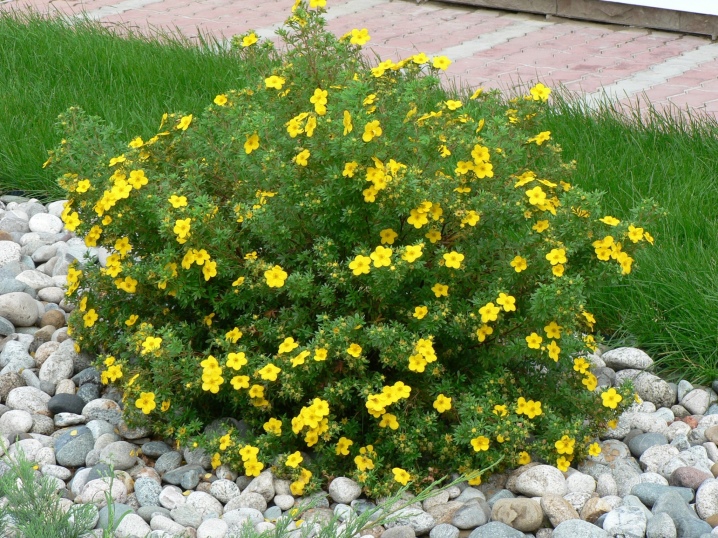
- We decorate the gazebo. In hanging pots, you can plant fragrant tagetes, petunia, pelargonium, and place cinquefoil around.
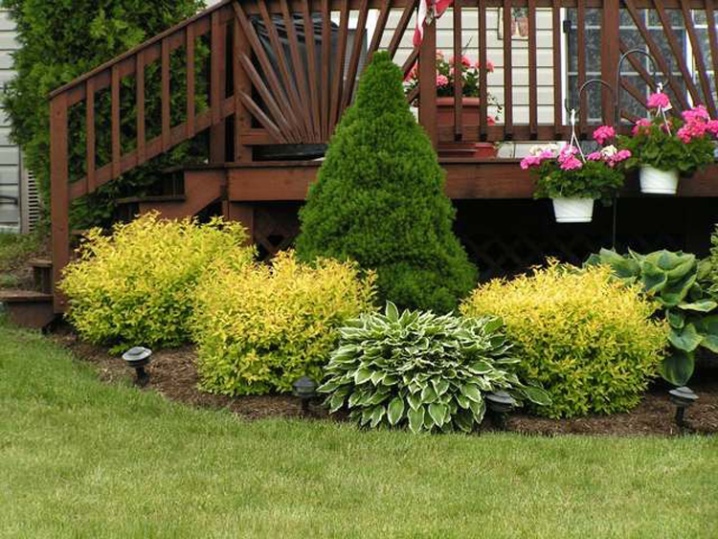
Planting and leaving Potentilla in the video below.



































































The comment was sent successfully.